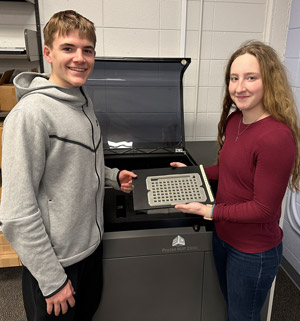Kent ISD — Pine Grove Instructor Rachel See showed 10-year-old Brantley Taylor a picture of a leprechaun holding a book.
“OK, so what is the leprechaun doing?” she asked. “Is he sitting? Can you tap the ‘yes’ key on your board?”
She guided Brantley’s hand over to a tablet where, through a keyguard and with some help, he located and then tapped the ‘yes’ key.
“Yeah, you did it!” See exclaimed, and Brantley broadcasted a bright smile.

Seeing a Need
A keyguard is a layer of hard plastic that is perforated with holes for the keys on a screen. Placed on top of a screen, the plastic fills up the spaces between the keys to help the user from unintentionally pressing multiple keys at once.
“Keyguards were one of the first things I noticed was needed when I first came here,” said Sophia Stevens, a speech language pathologist who joined Pine Grove Learning Center staff about a year ago.
“If a child needed a keyguard, the expense often had to be passed on to the parents,” Stevens added, noting that a specialized keyguard could cost around $100.
She recalled a student last year who had one that never fit properly. “We had to wrap it with a bunch of rubber bands, and it still did not stay on. It was such a pain.”
Envisioning one that would fit the school’s tablets, along with having bumps and ridges to help guide students’ fingers, Stevens started to search whether one could be designed. That led her to Kent Career Tech Center’s Lawrence Ridley, an engineering and architecture design instructor.
“I couldn’t believe it,” Stevens said. “He said if I could tell him what I wanted, he could design and make them.”
Passing Along a Feeling of Success
Ridley estimated it took about an hour to come up with the design and to create a prototype.
“We were going off an original design, but we just made it 200% better based on the needs of the students,” he said.
The design includes longer tabs for the keyguard to snap into the rubber guards that protect the tablets, as well as the guides and raised keys to indicate which ones students should use. Stevens only had a few minor changes to the prototype before 12 were created.
Two of Ridley’s students, Sparta High senior Reece Alt and junior Kennedy Zint from Forest Hills Central High, jumped at the opportunity to help. They both said they like using the program’s resin-based 3D printer to address a real-life problem.
“I also wanted to help with the project because I understand a little what it is like to not have the resources that you need to succeed,” said Kennedy, who added that she is dyslexic and said she did not always get a lot of support in reading.
“Eventually, through my years in school, I got the support I needed to succeed, and it’s the best feeling when I realized I was getting better at something that I was struggling with for so long. I wanted to let other students who have struggled have that feeling that I had.”

Opening the Communication Avenue
Brantley has cortical vision impairment, which makes it difficult for him to see a keyboard. The guides on the keyguard allow him to use touch to access the computer keyboard and communicate with staff.
“This has been an amazing project for our students,” Stevens said. “For some students, it is difficult because they can’t tell us what they see or feel. Recently one of our other students was working with staff and she was asked a question. By using the keyguard, she was able to find the word ‘sleep’ to answer. It was such an incredible moment because she was able to communicate.”
Two Pine Grove students already are using the keyguards. A few have been placed in the school’s resource library for students and families to check out and try. The design also has been stored and backed up, so more can be created. There is no cost to families as long as their child is a student at Kent ISD.
Read more from Kent ISD:
• Loves math, wants to work in medicine with children
• Creator and innovator











